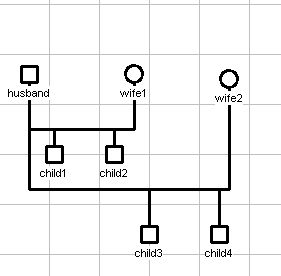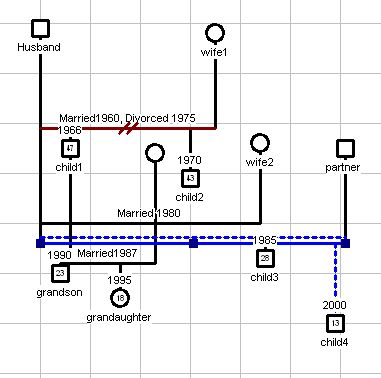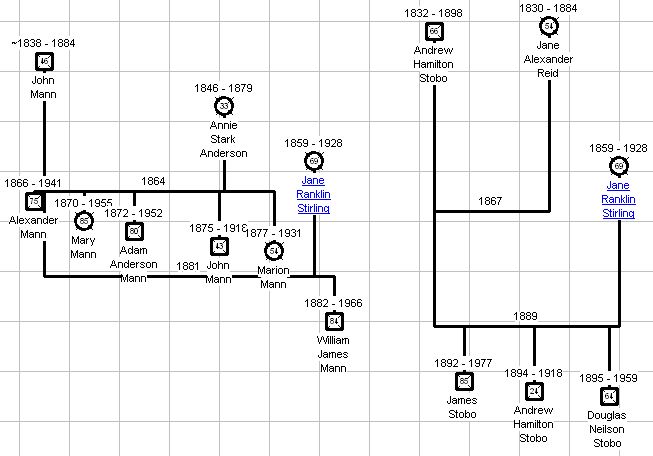|
By tazosmr - Monday, July 29, 2013
|
hi.
i think it is very problematic. When someone had two wives, for example like in this case1 .
it is hard to determine, if the child2 or child3 or child4, who was their mother? it is not an easy to say directly, because there is a straight line.
i think, it is better, that the diagram should be like the case2:
with the first wife, the line should be a bit thick, and with the second wife, there should be a different colored dotted line + with her children.

|
|
By appleshaw - Monday, July 29, 2013
|
You need to modify the diagram and then it can be quite clear.

|
|
By bogistad - Monday, July 29, 2013
|
The problem with your solution, Appleshaw, is that if child1 and child2 have a family, it is difficult to hang their children off them (the pedigree link would intersect the second marriage line).
I have always used the case1 solution and have had no problems with anyone understanding it. Using case2 (different coloured dotted line) to me indicates that the relationship with "wife2" is something other than a marriage.
I guess at the end of the day, it's whatever each person finds visually appealing.
|
|
By tazosmr - Monday, July 29, 2013
|
appleshaw
no, it is not a solution. why to start searching and manually modifying the diagram?it is very non-flexible and even hard.. i have the huge diagrams, and cat do that manually.
bogistad
And let there be an option. i.e. If it is not appealing for you, for me - it is a good solution. Let there should be a checkbox - if user wants, disables the dotted line for second marriage. But, by default, let it be a different lines.
Even, in the above picture, i have indicated, that they are wife1 and wife2, but on the program diagram, there appears only people's names, and it is even hard to know only by names, if wife1 and wife2 may be a husband-wife (because sometimes male and female names are not easy to diversify). so, i think, that it is essential to diversify the second marriage.
|
|
By fbukolyi - Monday, July 29, 2013
|
|
Maybe this will give some hint.
|
|
By tazosmr - Tuesday, July 30, 2013
|
I think, this is the best solution :: )

|
|
By appleshaw - Tuesday, July 30, 2013
|
If you use the built in GenoPro features you can convey a lot of information.
I prefer to use the grid as a graph to indicate relative ages. You can get people of similar age at different generations. Some people prefer to keep generations parallel. Matter of preference.
I do not have a problem with vertical lines crossing family lines and am quite happy to expand the family horizontally. Whatever format you choose might lead to a wide top family. One way round this is to use hyperlinks on the same display to take one sub family to the side.
The image below shows how complex family details can be shown. The shape of the individual shows whether the person is male or female and in this case is showing a third relationship with adopted children. This can also now be a marriage in some countries.
I find that automatic generation of family diagram is only useful for simple cases and would always re-arrange to get the best view. There are so many possibilities that the automatic arrangement can not be expected to satisfy everyone

|
|
By tazosmr - Tuesday, July 30, 2013
|
|
i dont meant that, but i just meant, that its good if there was just an option (checkbox in settings, or somewhere) and if i check it, it will show the second marriages (and the lines to the second wife's children) with different line. thnks. bye.
|
|
By Ian - Wednesday, July 31, 2013
|
The ability to create genograms to suit my family - not some hard fast rules which only complicate the layout. I use graphics to make it easier to understand where everyone fits relative to the rest of the family. This is why I chose this software as no other package I have seen come any where near this for clarity. The example below is what I use to illustrate talks I give to various genealogical groups. This family arrangement is very common in colonial NZ in the 1880's with wives dying young and husbands having accidents. I never use the Auto Arrange.
Ian
|
|
By appleshaw - Wednesday, July 31, 2013
|
Ian
I agree that a graphical display helps explain family links to otheres, and you can not expect auto arrange to cope with the sort of family yoy show.
Having said that I could not immediately understand it but used bdmhistoricalrecords.dia.govt.nz to check details. I think this is a good example of where a hyperlink makes things easier to understand what happened. A coloured emotional link line could be used to emphasise things.

|
|
By Ian - Thursday, August 1, 2013
|
The main point of my suggested layout was so all the same generation are on the same grid line so it is easier to see all the siblings and half siblings clearly. You will see I have ignored the convention of the wife being on the right of the husband - to me it is more important to see the generations clearly. I come from a CAD background and knew nothing of the genogram convention. The example is only a snippet showing two generations - in all cases the next generation married and had children but I left them off for clarity.
Ian
|
|
By 212529 - Friday, August 2, 2013
|
|
When multiple marriages are presented as in tazosmr's case 1-3 it is hard to determinate who is married with whom. Are child 3 and 4 descendants of Husband and Wife 2 OR Wife 1 and Wife 2? To avoid confusion one could use different colors for different marriages (as in case 1-3). Problem arises because different colors and line patterns are reserved for relationships other than marriage (thus transforming marriage toe.g. engagement). Appleshaw's approach avoid different coloration and line patterns for same relationship (e.g. marriage), but one could find such genograms confusing, because of hyperlink and crossed lines between generation line with relationship lines, etc. To me, best solution offered so farwas Ian's. He avoided different colorations and line patterns for same relationship, and he also presented multiple marriage situations without crossing lines between generations and relationships. I also use very similar approach. With one more detail. I draw first marriage/relationship line the lowest and next relationship a bit higher. With such approach reader can easily determinate which marriage was first and which second, without reading the dates of marriages. My experience shows that such genogram can be quite intuitive even for people who are not familiar with genograms. Here are examples of how I would draw genograms for all above cases:
|
|
By bogistad - Friday, August 2, 2013
|
212529 (02-Aug-2013)
When multiple marriages are presented as in tazosmr's case 1-3 it is hard to determinate who is married with whom. Are child 3 and 4 descendants of Husband and Wife 2 OR Wife 1 and Wife 2?
I think your three views further demonstrate that there is no really correct way of doing this but rather what is visually appealing to each person. Personally I find any view where the male is not on the LHS confusing. I find your third view very difficult to follow. In most cases, it's the male line which carries the name forward and to me it presents continuity down the generations. I prefer the traditional case1 diagram as do most people who have viewed my trees.
As for your example, even in today's enlightened and politically correct age, child 3 and child 4 would never be confused as descending from wife 1 and wife 2. As far as I am aware, it still takes a man and a woman to be biological parents :-)
Bob.
|
|
By 212529 - Sunday, August 4, 2013
|
[/quote]
As for your example, even in today's enlightened and politically correct age, child 3 and child 4 would never be confused as descending from wife 1 and wife 2. As far as I am aware, it still takes a man and a woman to be biological parents :-)
[/quote]
True. Unless child 3 and 4 would be adopted or fostered. And what if second marriage is without offspring? Is it still obvious to whom Wife 2 is married? I too was drawing male on LHS, until one of my relative, who was looking at the family tree, was quite surprised to see "same-sex marriages" were quite common in 18th and 19th century 
Anyway, this is just an example of how I would approach to above cases of multiple marriages, so there (I think) is less confusion with “who is married to whom situation”. Indeed, there is no really correct way how to draw multiple marriages 
|
|
By Johnnycrash - Monday, August 5, 2013
|
This is always on issue when trying to graphically display the complexity family groups can take.
I try and stick to a few rules to help create/decode any graphic:
People: Oldest to youngest - Left to right
Relationships: Oldest to newest - Top to bottom
Here is a few examples of how I handle this issue (all made up families). In these examples, there is NO abiguity as to who was married to who, and who their children are.
The creator is Child1, a descendant of Husband/Wife1. See if you can make heads or tails of these Genograms (and who was very naughty). 
This first example replicating tazosmr's dilema.



|